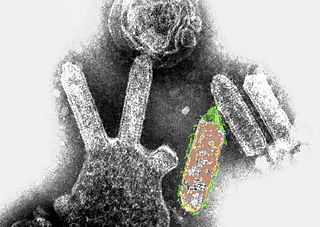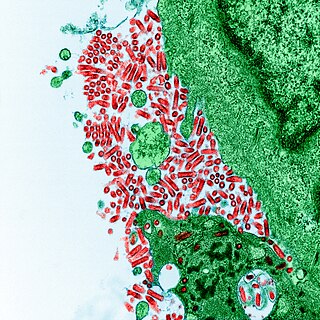
Lyssavirus is a genus of RNA viruses in the family Rhabdoviridae, order Mononegavirales. Mammals, including humans, can serve as natural hosts. The genus Lyssavirus includes the rabies virus traditionally associated with the disease of the same name.
Post-exposure prophylaxis, also known as post-exposure prevention (PEP), is any preventive medical treatment started after exposure to a pathogen in order to prevent the infection from occurring.

Rabies virus, scientific name Rabies lyssavirus, is a neurotropic virus that causes rabies in animals, including humans. Rabies transmission can occur through the saliva of animals and less commonly through contact with human saliva. Rabies lyssavirus, like many rhabdoviruses, has an extremely wide host range. In the wild it has been found infecting many mammalian species, while in the laboratory it has been found that birds can be infected, as well as cell cultures from mammals, birds, reptiles and insects. Rabies is reported in more than 150 countries and on all continents except Antarctica. The main burden of disease is reported in Asia and Africa, but some cases have been reported also in Europe in the past 10 years, especially in returning travellers.
Menangle pararubulavirus, also called Menangle virus, is a virus that infects pigs, humans and bats.

Australian bat lyssavirus (ABLV), originally named Pteropid lyssavirus (PLV), is a enzootic virus closely related to the rabies virus. It was first identified in a 5-month-old juvenile black flying fox collected near Ballina in northern New South Wales, Australia, in January 1995 during a national surveillance program for the recently identified Hendra virus. ABLV is the seventh member of the genus Lyssavirus and the only Lyssavirus member present in Australia. ABLV has been categorized to the Phylogroup I of the Lyssaviruses.
Mokola lyssavirus, commonly called Mokola virus (MOKV), is an RNA virus related to rabies virus that has been sporadically isolated from mammals across sub-Saharan Africa. The majority of isolates have come from domestic cats exhibiting symptoms characteristically associated to rabies virus infection.
Lagos bat lyssavirus, formerly Lagos bat virus (LBV) is a Lyssavirus of southern and central Africa that causes a rabies-like illness in mammals. It was first isolated from a fruit bat from Lagos Island, Nigeria in 1956. Brain samples from the bat showed poor cross-reactivity to rabies antibodies but the virus was found to be closely related to the rabies virus. This was the first discovery of a rabies-related virus. Until this time, rabies was thought to have a single causal agent.
Duvenhage lyssavirus (DUVV) is a member of the genus Lyssavirus, which also contains the rabies virus. The virus was discovered in 1970, when a South African farmer died of a rabies-like encephalitic illness, after being bitten by a bat. In 2006, Duvenhage virus killed a second person, when a man was scratched by a bat in North West Province, South Africa, 80 km from the 1970 infection. He developed a rabies-like illness 27 days after the bat encounter, and died 14 days after the onset of illness. A 34-year-old woman who died in Amsterdam on December 8, 2007, was the third recorded fatality. She had been scratched on the nose by a small bat while travelling through Kenya in October 2007, and was admitted to hospital four weeks later with rabies-like symptoms.
The little pied bat is a species of vesper bat in the family Vespertilionidae. It is found only in semi-arid woodlands in eastern Australia.

Rabies is a viral disease that causes encephalitis in humans and other mammals. It was historically referred to as hydrophobia due to the symptom of panic when presented with liquids to drink. Early symptoms can include fever and abnormal sensations at the site of exposure. These symptoms are followed by one or more of the following symptoms: nausea, vomiting, violent movements, uncontrolled excitement, fear of water, an inability to move parts of the body, confusion, and loss of consciousness. Once symptoms appear, the result is virtually always death, regardless of treatment. The time period between contracting the disease and the start of symptoms is usually one to three months but can vary from less than one week to more than one year. The time depends on the distance the virus must travel along peripheral nerves to reach the central nervous system.
Almost all human deaths caused by rabies occur in Asia and Africa.

In animals, rabies is a viral zoonotic neuroinvasive disease which causes inflammation in the brain and is usually fatal. Rabies, caused by the rabies virus, primarily infects mammals. In the laboratory it has been found that birds can be infected, as well as cell cultures from birds, reptiles and insects. The brains of animals with rabies deteriorate. As a result, they tend to behave bizarrely and often aggressively, increasing the chances that they will bite another animal or a person and transmit the disease.

Daubenton's bat or Daubenton's myotis is a Eurasian bat with rather short ears. It ranges from Ireland to Japan (Hokkaido) and is considered to be increasing its numbers in many areas.

Cryptic rabies refers to infection from unrecognized exposure to rabies virus. It is often phylogenetically traced to bats. It is most often seen in the southern United States. Silver-haired bats and tricolored bats are the two most common bat species associated with this form of infection, though both species are known to have less contact with humans than other bat species such as the big brown bat. That species is common throughout the United States and often roosts in buildings and homes where human contact is more likely.

The bat virome is the group of viruses associated with bats. Bats host a diverse array of viruses, including all seven types described by the Baltimore classification system: (I) double-stranded DNA viruses; (II) single-stranded DNA viruses; (III) double-stranded RNA viruses; (IV) positive-sense single-stranded RNA viruses; (V) negative-sense single-stranded RNA viruses; (VI) positive-sense single-stranded RNA viruses that replicate through a DNA intermediate; and (VII) double-stranded DNA viruses that replicate through a single-stranded RNA intermediate. The greatest share of bat-associated viruses identified as of 2020 are of type IV, in the family Coronaviridae.
European bat 1 lyssavirus(EBLV-1) is one of three rabies virus-like agents of the genus Lyssavirus found in serotine bats in Spain. Strains of EBLV-1 have been identified as EBLV-1a and EBLV-1b. EBLV-1a was isolated from bats found in the Netherlands and Russia, while EBLV-1b was found in bats in France, the Netherlands and Iberia. E. isabellinus bats are the EBLV-1b reservoir in the Iberian Peninsula. Between 1977 and 2010, 959 bat rabies cases of EBLV-1 were reported to the World Health Organization (WHO) Rabies Bulletin.

Cat bites are bites inflicted upon humans, other cats, and other animals by the domestic cat. Data from the United States show that cat bites represent between 5–15% of all animal bites inflicted to humans, but it has been argued that this figure could be the consequence of under-reporting as bites made by Felis catus are considered by some to be unimportant. Though uncommon, cat bites can sometimes cause rabies lead to complications and, very rarely, death.
West Caucasian bat lyssavirus (WCBL) is a member of genus Lyssavirus, family Rhabdoviridae and order Mononegavirales. This virus was first isolated from Miniopterus schreibersii, in the western Caucasus Mountains of southeastern Europe in 2002. WCBL is the most divergent form of Lyssavirus, and is found in Miniopterus bats (insectivorous), Rousettus aegyptiacus, and Eidolon helvum. The latter two are both fruit bats. The virus is fragile as it can be inactivated by UV light and chemicals, such as ether, chloroform, and bleach. WCBL has not been known to infect humans thus far.

The Sarawak rabies outbreak is an ongoing rabies outbreak in the state of Sarawak in Malaysia. Until 6 December 2022, 49 confirmed rabies cases and 44 deaths have been reported.
Yokose virus (YOKV) is in the genus Flavivirus of the family Flaviviridae. Flaviviridae are often found in arthropods, such as mosquitoes and ticks, and may also infect humans. The genus Flavivirus includes over 50 known viruses, including Yellow Fever, West Nile Virus, Zika Virus, and Japanese Encephalitis. Yokose virus is a new member of the Flavivirus family that has only been identified in a few bat species. Bats have been associated with several emerging zoonotic diseases such as Ebola and SARS.








